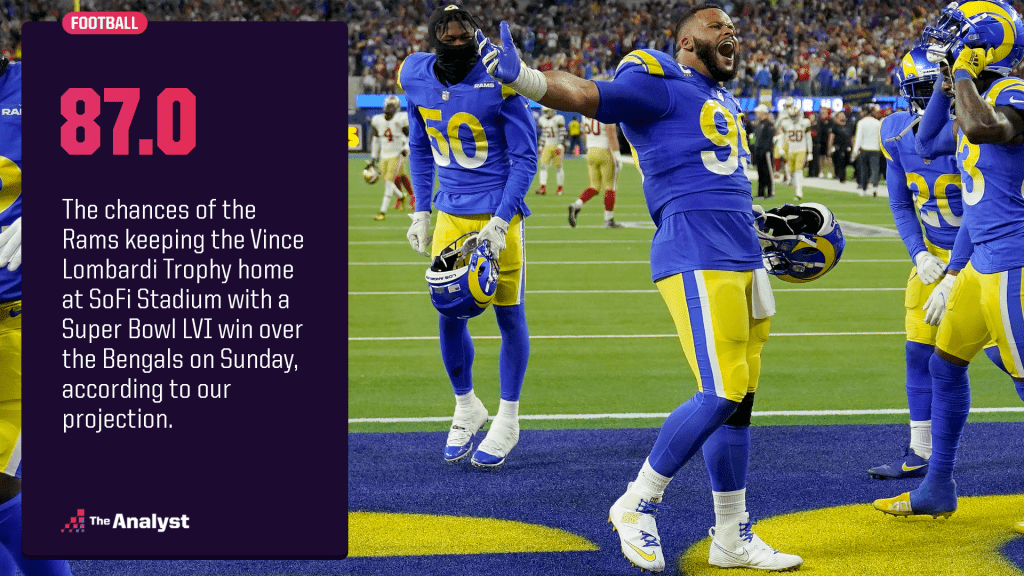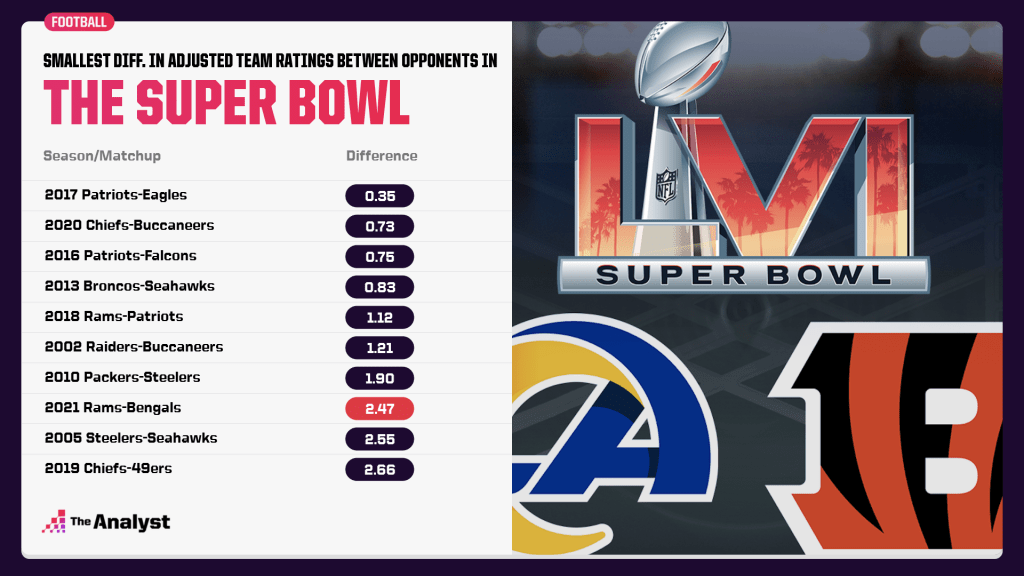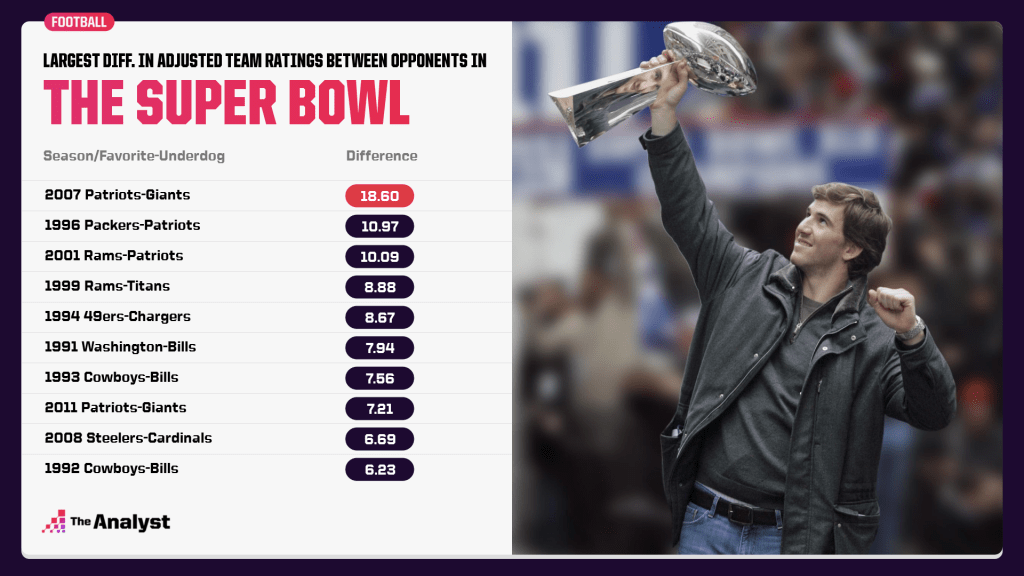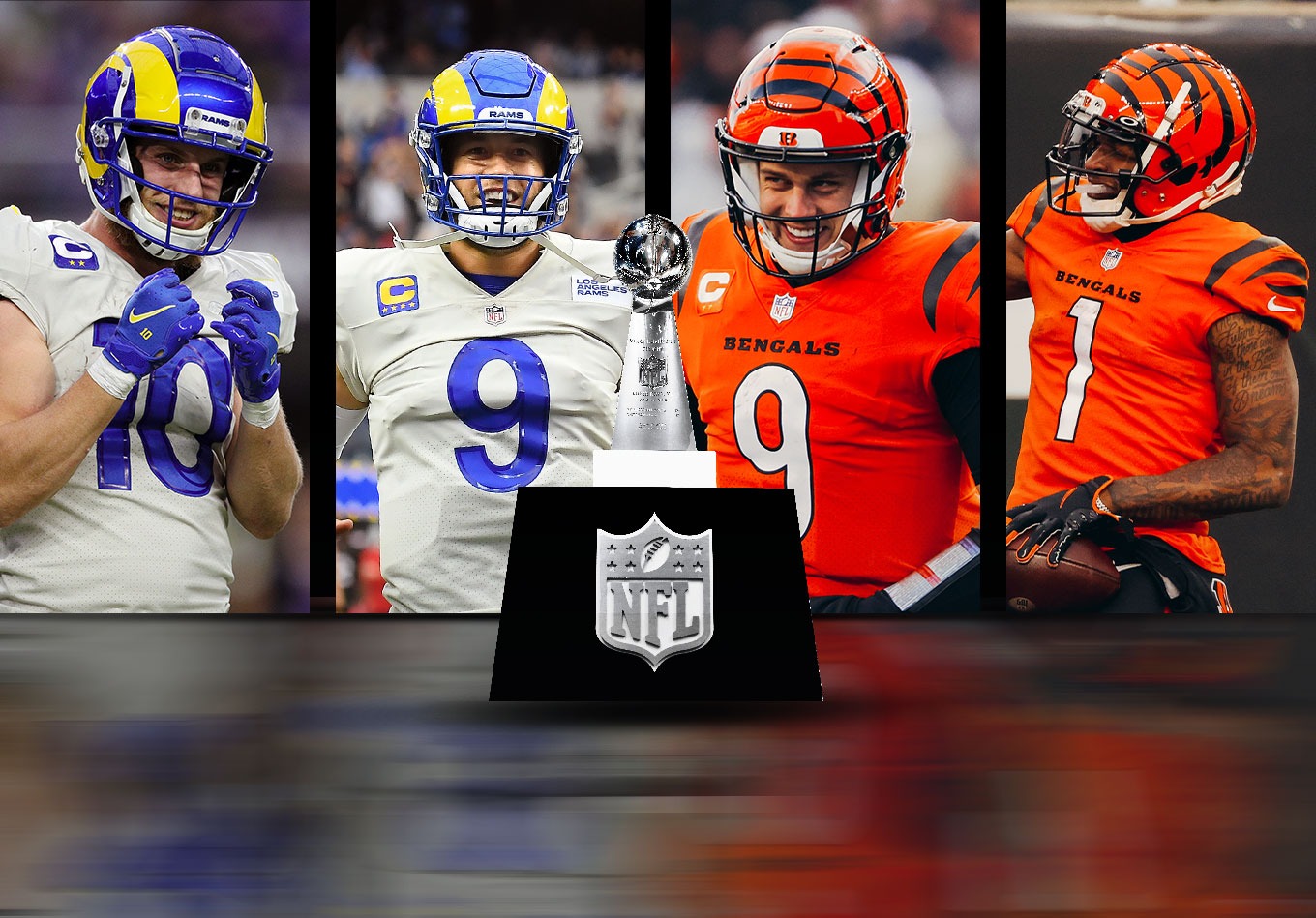The rumblings around Super Bowl LVI haven’t been so much about what the Cincinnati Bengals need to do to win, as much as it’s been about what they need to do to even have a chance against the more talented Los Angeles Rams.
That’s probably because this isn’t the matchup any of us expected when the playoffs began. Though our projection model gave the fourth-seeded Rams a 19.1% chance of winning the Super Bowl – second only to the Kansas City Chiefs (25.4%) – the fourth-seeded Bengals were given just a 1.9% chance.
Our rest-of-season or, in this case, postseason model projects every future game to give a predicted win percentage for each team across its remaining games. Rather than being a simulator of future games, the projections are calculated by looking at each team’s quarterback and QB EVE – performance in terms of yards added in expected passing situations – as well as team values for pass protection/pass rush, skill position players/coverage defenders and run blocking/run defense.
For the playoffs, the projection has been used to calculate each team’s odds of winning a home game against every postseason team, with those predictions then used to forecast each franchise’s chances of reaching and winning the Super Bowl.
Last week, prior to the conference championship games, the Rams were given a 38.2% shot – even better than the Chiefs’ 37.8% chance – to win the Super Bowl and the Bengals were the biggest longshot of the four remaining teams at 5.0%.
So where does this leave us after the Rams took care of business against the San Francisco 49ers and the Bengals stunned the Chiefs?
The likely outcome, at least according to our projection, is that the trophy will stay at SoFi Stadium with the Rams, who enter Sunday’s showdown with an 87.0% chance of winning Super Bowl LVI.

The Bengals’ status as massive underdogs even after making it this far is in part based on the struggles of an offensive line that ranked 25th in our pass protection win rate and allowed nine sacks in the divisional round win over the Tennessee Titans. Los Angeles ranked second in pass-rush win rate, meaning Cincinnati will be at a clear disadvantage in the trenches.
It’s an eye-opening difference in win probability to be sure, which makes us wonder where this Super Bowl ranks among the biggest one-sided matchups in recent memory.
To find out, we’re using an adjusted team rating model that takes data on both sides of the ball to calculate how many points per 10 drives better or worse conference championship teams from 1991-2021 were than the average team during those specific seasons.
From this model, we’re able to create an adjusted offensive rating, adjusted defensive rating and an overall adjusted team rating for those teams heading into the Super Bowl.
These adjusted team ratings are the same ones we used to determine that the 1995-96 Chicago Bulls were the best NBA champions since the 1986-87 season and that the 2020-21 Milwaukee Bucks were one of the worst. They’re important because they normalize a team’s performance from league environmental factors during a respective era that can either inflate or deflate its numbers.
What the model – and historical point spread numbers – reveal is that despite the pregame tone of this matchup and our projection that heavily favors the Rams, this is nowhere near the most one-sided matchup heading into a Super Bowl of the past 30 years.
The Rams have hovered around four-point favorites over the Bengals, which really isn’t all that unusual of a number. According to NBC, the biggest favorites in Super Bowl history were the Baltimore Colts against the New York Jets in Super Bowl III and the 49ers against the San Diego Chargers in Super Bowl XXIX. Both were 18-point favorites.
The Chiefs were three-point favorites over Tom Brady and the Tampa Bay Buccaneers a year ago before losing 31-9 at Raymond James Stadium.
This matchup isn’t even in the top 20 of the largest difference in adjusted team ratings between Super Bowl opponents since the 1991 season. It’s actually the eighth closest matchup of that span.

And now you’re wondering about the most one-sided Super Bowl matchups of the past 30 years. Let’s revisit them, starting with No. 3 and counting our way down.
3. Super Bowl XXXVI: New England Patriots 20, St. Louis Rams 17
Pre-Super Bowl Adjusted Team Ratings: Rams 16.0, Patriots 5.9
Brady’s legend was born in his first Super Bowl and the Patriots managed to slow down Kurt Warner and the “Greatest Show on Turf” Rams, who were seeking their second title in three years. As we’ve now seen too many times to count, Brady led New England on a final drive that set up the winning field goal as time expired. This was the second biggest upset in Super Bowl history in terms of spread, with St. Louis a 14-point favorite heading in.
2. Super Bowl XXXI: Green Bay Packers 35, New England Patriots 21
Pre-Super Bowl Adjusted Team Ratings: Packers 16.6, Patriots 5.6
With Brady not part of Patriots lore quite yet, the Packers intercepted Drew Bledsoe four times and Reggie White set one of several a Super Bowl records with three sacks. Brett Favre, who won his only title, hit Antonio Freeman on an 81-yard TD pass that was the longest in the game’s history and Desmond Howard returned a kickoff 99 yards for a record score. This was the only game in the top three in which the favorite actually won.

1. Super Bowl XLII: New York Giants 17, New England Patriots 14
Pre-Super Bowl Adjusted Team Ratings: Patriots 21.7, Giants 3.1
This is probably the one most people guessed would be No. 1 on the list. The Patriots entered the contest 18-0 and with the highest adjusted team rating of any conference champion over the past 30 years. But New York’s defense found a way to hold down Brady and New England’s historically good offense and Eli Manning found Plaxico Burress for the go-ahead score with 35 seconds left. This was the third-biggest upset in Super Bowl history in terms of point spread with the Patriots favored by 12.5.
What does it all mean for Sunday? Anything can happen.
Enjoy this? Subscribe to our mailing list to receive exclusive weekly content.
Data modeling by Kyle Cunningham-Rhoads and Matt Scott. Nicholas McGee contributed. Graphic design by Matt Sisneros.
